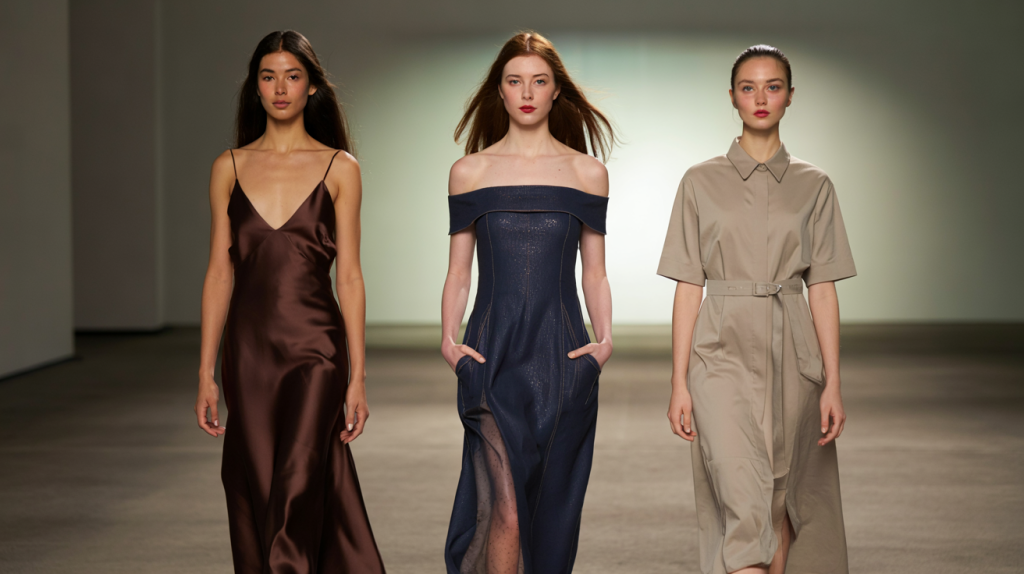New hemlines, smarter fabrics, and a softer kind of glamour: 2026 dresses pivot to longevity and ease. Think fluid silhouettes that move, quiet shine after dark, and accessories dialed down so the cut does the talking.
The shift is not just mood. Rental and resale are reshaping how we buy event dresses, while runways have already flipped the switch toward clean lines. The signal is clear: fewer micro-fads, more pieces that live in real wardrobes.
Tendances robes 2026: the big picture right now
The main idea lands fast: everyday elegance wins. Sleek column maxis, updated shirt-dresses, and refined slip styles take over, with discreet draping and low-key sparkle at night. Comfort stays center stage through breathable weaves and bias cuts.
Occasion dressing changes as well. Cocktail looks go less frothy, more sculpted. Sheer layers stay, but smarter – lined where it counts, shown where it flatters. And yes, pockets in formal dresses are sticking around.
The problem most shoppers face is noise. Social feeds push weekly novelty, yet budgets and storage say no. 2026 rewards focus: a better cut, a breathable fabric, and a color palette that works Monday to party.
Cuts, colors, fabrics: what dresses look like in 2026
Silhouettes calm down. Expect long column dresses with a nipped waist, halter or off-shoulder necklines, and refined drop-waist day dresses. Bubble hems reappear in a smaller, grown-up way. Mini lengths exist, but mid-calf is the sweet spot for work to dinner.
Fabrics go tactile. Cupro and Tencel lyocell bring that suede-like drape for slips. Crisp poplin for shirt-dresses survives heat. Recycled satin and crepe step in for evening so the shine looks rich, not flashy.
Color moves to workable shades: deep chocolate, ink navy, stone, soft pastels, with a single red or silver accent for night. Sequins shrink to micro paillettes. The goal is glow, not glare.
Data signals behind the shift
Rental and resale keep growing, and dresses are prime targets for that rotation. The ThredUp 2024 Resale Report estimates the U.S. secondhand market reached 43 billion dollars in 2023 and could hit 73 billion dollars by 2028 (ThredUp, 2024). That means more consumers want quality that survives multiple lives.
Waste awareness pushes better materials. The Ellen MacArthur Foundation highlighted that a truckload of textiles is landfilled or incinerated every second globally (Ellen MacArthur Foundation, 2017). Designers respond with recycled blends and deadstock runs for occasionwear, especially in satin and crepe.
Forecast accuracy is improving on the consumer side too. Pinterest said 80 percent of its 2023 style predictions materialized, a stat it repeated in its 2024 report (Pinterest Predicts, 2024). Translation: the dress shift toward minimal lines and tactile finishes is unlikely to be a short blip.
How to wear 2026 dress trends without regret
A few traps to avoid. Chasing a hyper-specific viral cut that only works standing still. Forgetting lining quality in sheer styles. Ignoring the midday heat factor when buying a work dress in heavy viscose. It happens.
One real-life route: a bias-cut slip in cupro for 18-hour stretch, a poplin shirt-dress with a detachable belt for commute comfort, and a compact column gown in recycled crepe for weddings. Three silhouettes, many lives.
Fit stays king. Tailoring a waist, raising a hem by two centimeters, or swapping buttons can extend wear by years. This is where rental and resale also pay off: try the silhouette, then invest when the cut proves itself.
Here is a simple checklist to turn 2026 trends into a wardrobe that lasts.
- Pick one hero silhouette: column, slip, or shirt-dress. Build outfits around it for a month.
- Touch-test fabric: if it breathes and springs back, it handles heat and travel days.
- Check construction: lined where needed, seams smooth, zipper easy. Evening dresses should sit, not only pose.
- Choose a tight palette: navy or chocolate for day, one statement night shade like red or silver.
- Plan the dress journey: wear, then rent out or resell. 2026 rewards pieces that circulate.
Why this works now: the market backs durability with real dollars, rental platforms want timeless cuts, and designers are delivering cleaner lines. Minimalism does not mean boring – it means the shape carries the look.
The last missing piece is timing. Shop transitional fabrics at the end of holiday season when returns hit platforms, then tailor. A small tweak turns a favrite into a forever dress.
And when in doubt, step back from the scroll. Try the dress in motion, take a seat, check the pocket placement, feel the fabric against the skin. If it lives well for a day, it will live well for 2026 and beyond.
